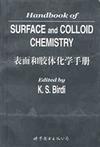表面和胶体化学手册
1970-1
世界图书出版公司
K.S.Bridi(ed.)
763
无
The application area of surface and colloid science has increased dramatically during the past decades. For example, the major industrial areas have been soaps and detergents, emulsion tech- nology, colloidal dispersions (suspensions; nanoparticles), wetting and contact angle, paper, cement, oil recovery, pollution control, fogs, foams (thin liquid films), food industry, biomembranes, mem-branes, and pharmaceutical industry. Recently, new areas of applications are developmg, one of which is the synthetic transplants and biological monitors. These trends show the importance of this field of science in everyday life.
Dr. K.S. Birdi received a B.Sc. degree in Chemistry from Delhi University, Delhi, India, in 1952.He then traveled to the U.S. for further studies, majoring in chemistry at the University of alifornia at Berkeley. After graduation in 1957, he joined Standard Oil of California, Richmond. Dr. Birdi married and moved to Copenhagen in 1959, where he joined Lever Bros., in 1959 as Chief-Chemist, Development Laboratory. During this period he became interested in surface chem-istry and joined, as assistant professor, the Institute of Physical Chemistry (founder of institute:Professor J. BrOnsted), Danish Technical University, Lyngby, Denmark, in 1966. He irutially did research on surface science aspects (e.g. detergents; rrucelle formation; adsorption; biophysics).During the early exploration and discovery stages of oil and gas in the North Sea, he got involvedin Research Science Foundation rograms, with other Research Institutes around Copenhagen, in the oil recovery phenomena and surface science. Later, research grants on the same subject were awarded from the European Common Market projects. These projects also involved extensive visits to other universities and an exchange of guests from all over the world. Dr. Birdi was appointed Research Professor in 1985 (Nordic Science Foundation), and was then appointed, in 1990, to the School of Pharmacy, Copenhagen, as professor in Physical Chemistry. There was continuous involvement with various industrial contract research programs through-out these years. These projects have actually been a very important source ofinformation in keeping up with real problems, and helped in the guidance of research laruung at all levels. Professor Birdi is a consultant to various national and intemationalindustries. He is a member of various chemical societies, and a member organizing committees,of national and international meetings related to surface science. He is a member of selection committees for assistant professor and professor, and was an advisory member (1985-1987) of the ACS journal: Langmuir. Professor Birdi has been an advisor for some 90 advanced student projects and various Ph.D.projects. He is the author of some 100 papers and articles (and a few hundred citations). In order to describe these research observations and data he realized that it was essential to write books on the subject. His first book on surface science was published in 1984: Adsorption and the Gibbs Surface Excess, Chatorraj, D.K. and Birdi, K.S., Plenum Press, New York. Further publications include Lipid and Biopolymer Monolayers at LiqLuld Interfaces, K.S. Birdi, Plenum Press, New York, 1989; and Fractals, in Chemistry, Geochemistry and Brophysrcs, K.S. Birdi,Plenum Press, New York, 1994. Surface chemistry has remained his major interest of research throughout these years.
Chapter 1Surface and Colloid ChemistryChapter 2Interfacial Interactions of LiquidsChapter 3Surface Tension and Interfacial Tension of LiquidsChapter 4Thermodynamic Properties of Surfactant SolutionsChapter 5Micellar Systems and Microemulsions: Solubilization AspectsChapter 6Foams and Antifoams: A Thin Film ApproachChapter 7Dielectric Spectroscopic Characterization of EmulsionsChapter 8Solubilization in Aqueous Surfactant SystemsChapter 9Surface Tension of PolymersChapter 10Cohesion Energy Parameters Applied to Surface PhenomenaChapter 11Chemical Physics of Colloid Systems and InterfacesChapter 12Colloidal Assemblies Used as MicroreactorsChapter 13Scattering and Absorption of Light by Particles and AggregatesChapter 14Colloid Systems and Interfaces - Stability of Dispersions Through PolymerChapter 15Particle Engineering of Drug-Loaded Nanoparticles and Their PotentialChapter 16Membrane Mimetic Systems as Compartments for Advanced MaterialsChapter 17Surface Properties of Lipids and Proteins at Bio-InterfacesChapter 18Application of Surface-Active Agents in Petroleum ProductionChapter 19Application of Scanning Tunneling Microscopy (STM) and Atonuc ForceMicroscopy (AFM) in CoUoid and Surface ChemistryIndex
A major drawback of the conventional DLS experiment is that the dispersion must be transparent for the light beam. For micrometer-sized particles, this requires concentrations below lO-s vol%.Often the concentration of the samples is higher and their dilution for investigation is not desirable The autocorrelation function of multiply scattered light is difficult to interpret and to extract subsequent information about the particle size. Several modifications have been proposed during the last few years aimed at overcoming this problem and extending the application of DLS to more concentrated suspensions. One possibility is to use678,679 a very tlun sample cell of an optical path length below 100 Um in order to reduce the multiple scattering as much as possible. Altematively, Phillies680 suggested using a more complicated optical system comprising two laser beams and two detectors located at +900. The cross-correlation of the signals from the two detectors was measured. The corresponding theoretical analysis was presented by Dhont and de Kruif.681 Another two-detector optical system was proposed by Drewel et al.682 which allowed measurements at scattering angles between 20 and 1200. Due to the complex equipment and alignment procedures, these optical systems so far have found limited application. ……

无
全英文,要费功夫了,书装订有点问题